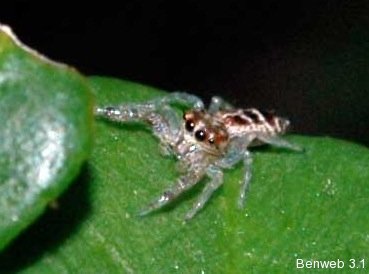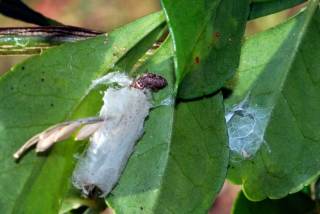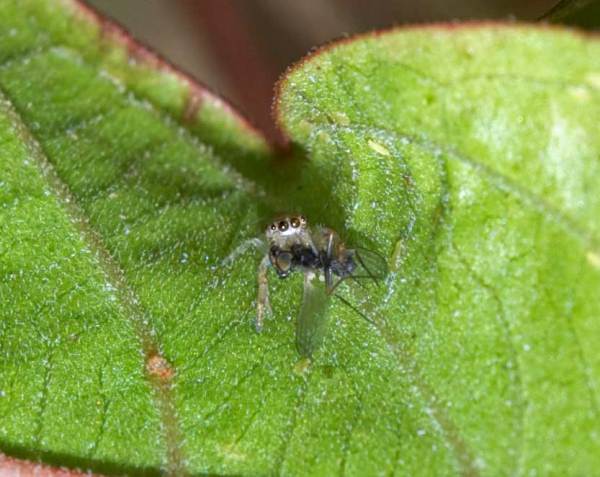One of the more interesting “free-range” groups of spiders is the family Salticidae, the jumping spiders. They have one pair of marvelously large eyes situated prominently up front, which is what provides them the depth perception they need to coordinate their incredible jumping ability. They use this ability to leap from point to point to capture their prey and to get around from one plant to another.
One day as I was out taking my routine census of the wild lime bush in the back yard, I noticed that two adjacent leaflets had been sort of stuck together. Now, whenever you notice something like that, you have to get your camera out to see if you can find out what did it. It could be a lepidopteran larva just taking a nap or getting ready to pupate; it could be a spider setting a trap; or it could b something else. In this case, it was a small (teeny, maybe 5 mm long) jumping spider in the genus Hentzia. There are five species in the continental United States, with only four in Florida: H. palmarum, H. mitrata, H. grenada, and a south Florida specialty (for the U.S., at least; it’s also found in the Bahamas and on Cuba) is H. chekika.
This particular spider looks like this:
You can see the large eyes that are characteristic of all salticids, and you can see the body shape that is characteristic of the genus Hentzia: “somewhat elongate,” according to the last revision of the genus, from 1989. If you want to get technical about it, here are some more precise characteristics as noted by Richman:
The genus Hentzia is here defined by the presence of both pencils of hair below the posterior median eyes and spatulate hairs on the ventral retromargin of the first patella and distal femur. These characteristics are most pronounced in the female, especially in regard to the hair pencils. Males often have elongated chelicerae and somewhat elongate bodies.
These spiders have a circum-Caribbean distribution, and most of the different species are presumed to have resulted from island speciation (the tendency of isolated breeding populations of a once-more-widespread species to develop unique traits that define it as a separate species).
Although there are only a few species from which to choose, I was unable to take a photograph that showed sufficient detail to place the spider to the species level, but I’m happy to know that it’s a Hentzia.
Here is what I believe to be the egg sac of this same (or perhaps another) individual; it gives its location away by the way the adjacent leaves stick together:
And today as I was tending the firebush (sadly, the scale saga continues) I noticed a tiny creature scuttle from the top of the leaf to the side away from me. Curious, I flipped the leaf over and snapped a few pictures; it was so small I didn’t have any idea what I’d found. But it turns out to have been one very happy Hentzia (presumed) spider:



